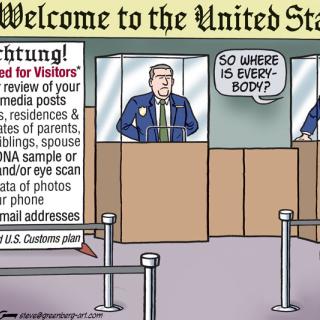To your surprise, perhaps, my answer is an emphatic, unqualified NO. In this Busting Myths column, I will be schematic, but I am prepared to expand my understanding of both city and state in response to readers’ questions. For background, I refer you to my essays on the city and state published in Columbus Free Press since September 2021, available on the website.
Is Columbus really a City: That’s capital “C” City as in legally established, organized, managed?
Despite ranking 14th in the United States and growing, Columbus has no identity or sense of itself as an urban place. It has no agreed-upon landmark(s). Consider the Columbus Dispatch’s amateur “historians’” flailing efforts. Being one of innumerable Columbuses or Columbias across the nation is only one indicator. Its media are well below average. And, it has no signature professional sports team or mascot. Brutus Buckeye and “Carmen, Ohio” don’t cut it.
More importantly, it is the largest U.S. city without representative government. Its elected at-large City Council is a vestige of elite-controlled urban politics of the first one-half to two-thirds of the 19th—certainly not the 20th or 21st—centuries. The tiny shift to Councilors living in an arbitrarily designated “district,” but still elected at-large in city-wide contests, is an insult to its residents.
Although mega-cities like New York and Chicago do not have a single city manager, they have alternative administrative structures. Of cities in its population and economic groupings, Columbus stands out for not having a city manager.
As any resident with problems learns immediately, Columbus reflects its lack of organization and communications every day, in every department, at every turn. In its level of failed communications and disorganization, it truly is in a league of its own. My familiarity has been a trial by fire over 18 years as a University District homeowner and more recently in my efforts to prompt both responses and partial solutions to everyday and more drastic urban problems.
My education leaped forward one day last spring when a City Council legislative aide sat at my dining room table and patiently explained whom to contact for which problems and questions. They patiently explained that no one can decode this from the City’s website.
My understanding and my confusion move forward in lockstep. As a retired university professor with time, communication skills, self-confidence, and perseverance, the “squeaky wheel” in what I term the “do-it-yourself city” can stimulate changes. I have brought elected officials and mid-level staff together, many for the first time, over Zoom and across my dining room table. I have brought representatives of the City and Ohio State University together. During last fall’s football season, I brought the separate City departments responsible for regular trash and recycling together and prompted trash inspection of properties in the University District on Monday mornings. “Squeaky wheel” influence is undemocratic.
But that level of responsibility did not continue. I also learned that Columbus’ basic 311 complaint reporting system is understaffed (fewer than 20 people for hundreds of reports each day) and part-time (Monday-Friday, 8:00-5:00) while certain Columbus Police responses require a 311 report. City Council apparently doesn’t appreciate that crime and other offenses do not limit themselves to business hours. (Ohio State’s failed responses to crime in the University District also presume that crime is only a Wednesday-through-Saturday, 7:00 p.m.-3:00 a.m. phenomenon.)
Neither City Councilors, who function singularly despite not representing their own district, nor the Mayor who spouts slogans and knows little about the city, have either their own or a unified vision for Columbus as a city. Neither do the so-called city planners, who are not urban planners. Even in a city historically dominated by developers, as Columbus is, no knowledgeable planner would approve permission to build a 32-story or higher building beside 2- to 4-story structures.
Inexplicably, no Columbus city department researches the successes and failures of other cities. This is the case with electric scooters, gun buybacks, university-community relationships, to mention only a few examples about which I’ve learned—and given advice—this year.
I do not understand City Council meetings. One of the highly responsible legislative aides recommended that I enroll for email Council and committee meeting notices. I now receive duplicative announcements almost never with an agenda, outline, or questions. Nevertheless, they ask for public input in person, email, or video link. But on what? This is a charade. I submitted testimony once, but there was no discussion before approval of the unsubstantiated proposal.
The Mayor rambles unknowledgeably about his “commitment” to “equity.” His office will not answer my questions about why Columbus is not a member of the national Mayors Organized for Racial Equity (MORE), unlike Los Angeles and Denver and at least ten other U.S. cities.
Columbus consists of pockets of overdevelopment and many more of underdevelopment. This follows the patterns that geographer Kevin Cox documents in Boomtown Columbus (Ohio State University Press, 2021) of developers’ control, with the City’s and its major institutions’ direct assistance. One dimension of the latter is uneven and inequitable growth and the foundation for development through land annexation. Another is the City’s and Ohio State’s joint destruction of the historic and beautiful University District—by the City’s failure even to enforce its long out-of-date zoning laws, and OSU’s refusal to develop and enforce responsible policies.
Ironically, Columbus’ long overdue revision of its zoning laws is prompted by the grab for more power by developers—not citizens, homeowners, or neighborhood organizations. The developers do not wish to continue requesting their almost immediately approved requests for exemptions from existing laws. They want greater control of the city.
In a phrase, Columbus’ City Council and Mayor follow the “Columbus Way.” That consists of series of insubstantial slogans; separate hobby-horse projects of mayors and councilors that do not integrate or build on or into an urban vision; Band-Aids for immediate problems like safety, housing, teen violence, and pre-schooling rather than city-wide plans with goals, budgets, and timetables; all linked through their lack of knowledge of the city as a whole. One sign of many: Columbus’ U.S. Postal Service office is one of the worst-managed and worst-performing in the country—without any comment about the long-standing problems from the City.
These failings underlie and connect the massive limitations of the Columbus Police Department, Public Health, Public Schools, 311, zoning, infrastructure, roads, and transit. Like the developers who propose inappropriate high rises and unaesthetic downtown “art hubs,” the City itself parallels its domineering developers with big-ticket items like the exorbitant $200,000 buyout for CPD officers to leave the force or other scattered actions that filled the Mayor’s recent “State of the City” speech. That “address” misstated the city’s “progress” over the past year and misrepresented “affordable housing” with an inadequate proposal. (See Mark Ferenchik, “State of the City: Ginther calls for bond issue with at least $150M for affordable housing”; compare with Theodore Decker, “After mayor’s address, we should remember the brave and quiet of Columbus.”)
The Columbus Way is the long-ago misconceived and disproven, “trickle-down” approach.
---------------------------------------------------------------
Harvey J. Graff is Professor Emeritus of English and History and Ohio Eminent Scholar at The Ohio State University. He is the author of many books on social history. His Searching for Literacy: The Social and Intellectual Origins of Literacy Studies is forthcoming. His essays appear in Inside Higher Education, Times Higher Education, Washington Monthly, Academe, Publishers Weekly, Columbus Free Press, and other outlets.



